Chertsey, Surrey, England, UK – Sunday, June 6th, 2010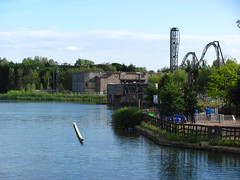
chav (t?æv) — noun. (British slang, derogatory) a young working-class person whose tastes, although sometimes expensive, are considered vulgar by some.
I wasn’t familiar with this term before I came to England, but after opening my ears to the local parlances I began to hear it used a lot, and almost always in reference to Thorpe Park. The park is said to be filled with chavs; sideways baseball caps, loose-fitting sportswear, fake jewelry, bad teeth, used McDonalds wrappers… this is who you will be standing in line next to at Thorpe Park, engaged in conversation with other chavs consisting exclusively of profanity that would be imaginative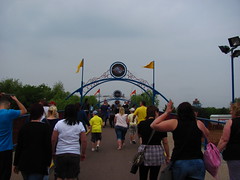 if only it were intelligible. Despite the lamentations of British park fans everywhere that one of the few places they can go on decent thrill rides must be shared with such a sketchy clientele in a somewhat seedy setting, this seems to be how Thorpe Park and Merlin have intended it, segmenting each of their three London-area parks to cater to a specific market (one for the children, one for the whole family, and one for the probation violators). It’s a clever alternative to the one-size-fits-all approach that other regional operators use, and a uniquely British solution to theme park marketing. Gotta keep those social classes segregated somehow! However I will testify from my own experiences, if anyone thinks that Thorpe Park’s population is ‘scary’ beyond being simply stupid-as-nails, they’ve obviously never been to the Six Flags parks in New Jersey,
if only it were intelligible. Despite the lamentations of British park fans everywhere that one of the few places they can go on decent thrill rides must be shared with such a sketchy clientele in a somewhat seedy setting, this seems to be how Thorpe Park and Merlin have intended it, segmenting each of their three London-area parks to cater to a specific market (one for the children, one for the whole family, and one for the probation violators). It’s a clever alternative to the one-size-fits-all approach that other regional operators use, and a uniquely British solution to theme park marketing. Gotta keep those social classes segregated somehow! However I will testify from my own experiences, if anyone thinks that Thorpe Park’s population is ‘scary’ beyond being simply stupid-as-nails, they’ve obviously never been to the Six Flags parks in New Jersey,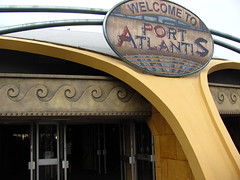 Los Angeles, Chicago or D.C. back when the old management’s idea of smart marketing was to give every local youth a season pass for $25. The chaviest thing I witnessed at Thorpe was on the prelift of Nemesis Inferno where some kid was waiting next to the netting to shower everyone with silly string. The rest of the park populace was mostly middle class types muttering ‘chavs’ under their breath.
Los Angeles, Chicago or D.C. back when the old management’s idea of smart marketing was to give every local youth a season pass for $25. The chaviest thing I witnessed at Thorpe was on the prelift of Nemesis Inferno where some kid was waiting next to the netting to shower everyone with silly string. The rest of the park populace was mostly middle class types muttering ‘chavs’ under their breath.
Thorpe Park should be more interesting than it actually is. The entire park is built around a chain of islands in an inland lake system, one of those unique RollerCoaster Tycoon-type landscapes where the entryway consists of a long bridge to a gigantic indoor dome centered on its own island, and when you exit the other side of the Atlantean gift complex you have  the entire thrill ride smorgasbord laid out in front of you. It seemed reminiscent of a Cedar Point visit, only with ¼ of the rides at ½ size. To the right we have mini-Top Thrill Dragster, further inland are mini-Raptor and mini-Power Tower, a collection of flat rides to our left include mini-Skyhawk and mini-MaXair plus a mini-Disaster Transport, and in the back corner there’s the blue tracked record-breaker from Intamin and beyond that the newest beyond vertical drop coaster with a layout split in two parts and operates
the entire thrill ride smorgasbord laid out in front of you. It seemed reminiscent of a Cedar Point visit, only with ¼ of the rides at ½ size. To the right we have mini-Top Thrill Dragster, further inland are mini-Raptor and mini-Power Tower, a collection of flat rides to our left include mini-Skyhawk and mini-MaXair plus a mini-Disaster Transport, and in the back corner there’s the blue tracked record-breaker from Intamin and beyond that the newest beyond vertical drop coaster with a layout split in two parts and operates with short vehicles. It’s somewhat disappointing then that given all this potential it manages only to be a middling amusement park that does little to take advantage of potential the natural environs (save for the overcast weather mixed with dark paint schemes that always makes the rides impossible to photograph). Except in Canada Creek and over by the Saw attractions you can’t even see all the surrounding water and woodlands (and Saw is the one ride where the freeing view of a natural watershed seems malapropos for the clasterphobic, industrial grime theme). Thankfully the rides themselves are, on the whole, still pretty good.
with short vehicles. It’s somewhat disappointing then that given all this potential it manages only to be a middling amusement park that does little to take advantage of potential the natural environs (save for the overcast weather mixed with dark paint schemes that always makes the rides impossible to photograph). Except in Canada Creek and over by the Saw attractions you can’t even see all the surrounding water and woodlands (and Saw is the one ride where the freeing view of a natural watershed seems malapropos for the clasterphobic, industrial grime theme). Thankfully the rides themselves are, on the whole, still pretty good.
Decently presented, too. While it would be easy to level criticism that the park’s efforts to theme its attractions are often half-hearted and prone to deterioration, I was pleased enough to find a thrills-based park for whom any aesthetic presentation remained a concern at all. This was most apparent in my first attraction, Colossus, where the spiraling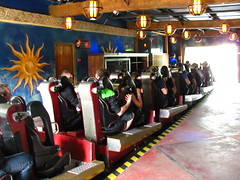 blue corkscrew coil around a tropically vegetated, layered landscape with enough canyons and tunnels that you forget momentarily that the layout blueprints were borrowed from an existing ride and expanded with two extra heartline rolls at the far end to get the inversion record. The wait seemed to be the longest after opening (about a half hour) and decreased as the day went on to under five minutes by closing. Based on other reviews I may have expected the reason for this to be that everyone else in the park learns
blue corkscrew coil around a tropically vegetated, layered landscape with enough canyons and tunnels that you forget momentarily that the layout blueprints were borrowed from an existing ride and expanded with two extra heartline rolls at the far end to get the inversion record. The wait seemed to be the longest after opening (about a half hour) and decreased as the day went on to under five minutes by closing. Based on other reviews I may have expected the reason for this to be that everyone else in the park learns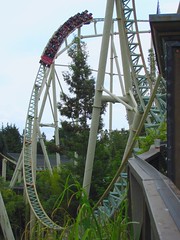 from their first experience that it’s a horrible rough ride that does not need to be attempted again; however, I discovered this trend simply meant more rides for me. The most uncomfortable issue with the design was the limited foot room especially in the front rows. My legs were long enough that after the restraint was pulled down I could feel my heel ‘locked in’ against the metal floor of the car, and being completely unable to move or stretch my legs at one point even induced a mild claustrophobic attack while waiting on the brake run for the station to clear. I generally tried to get a rear seat row with a bit more legroom after that.
from their first experience that it’s a horrible rough ride that does not need to be attempted again; however, I discovered this trend simply meant more rides for me. The most uncomfortable issue with the design was the limited foot room especially in the front rows. My legs were long enough that after the restraint was pulled down I could feel my heel ‘locked in’ against the metal floor of the car, and being completely unable to move or stretch my legs at one point even induced a mild claustrophobic attack while waiting on the brake run for the station to clear. I generally tried to get a rear seat row with a bit more legroom after that.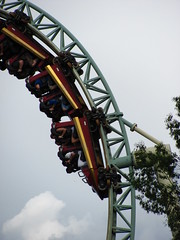
Cresting the 100 foot tall chain lift, the train ambles along a gradual curving first drop that takes its time building up to full speed before the final part of the descent sends us hurling into the first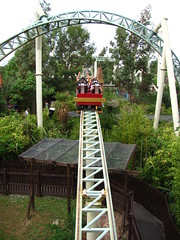 of ten inversions. I was expecting to be beaten around a fair amount at this point, but minus some occasionally strong vibrations I was easily able to keep my head looking straight and neck out of contact with the harness. After the first vertical loop there’s a long shallow airtime hill under a building and extending farther down into a watery trench. I was reminded slightly of Drachen Fire, one of the few other multi-looping coasters ever built to feature an extended
of ten inversions. I was expecting to be beaten around a fair amount at this point, but minus some occasionally strong vibrations I was easily able to keep my head looking straight and neck out of contact with the harness. After the first vertical loop there’s a long shallow airtime hill under a building and extending farther down into a watery trench. I was reminded slightly of Drachen Fire, one of the few other multi-looping coasters ever built to feature an extended moment of negative G’s early in the layout; you don’t get it too often but I enjoy the variety.
moment of negative G’s early in the layout; you don’t get it too often but I enjoy the variety.
The cobra roll is a larger maneuver than it looks due to the trench location, and it’s a very smooth, graceful element. Too smooth and graceful to be honest, as both inverting crests and the bowl between them are very wide and rounded with almost no snap, although I suspect any more intensity wouldn’t work very well with the ergonomics of the vehicle seating. There’s a brief underground (but over water) s-curve that nicely anticipates the upcoming corkscrew; I honestly appreciate and remember little design quirks like that even more than the big elements themselves. The double corkscrews aren’t just the geometrically circular Arrow Dynamics variety; they instead feature a rotational snap at the top with an extended pause in between to keep the dynamics interesting (along with more tunnels and foliage flybys). They’re also possibly the roughest part of the ride, but again, maybe I just got to go on a day when the calibration was good because I never encountered any real problems with the trackwork.
Too smooth and graceful to be honest, as both inverting crests and the bowl between them are very wide and rounded with almost no snap, although I suspect any more intensity wouldn’t work very well with the ergonomics of the vehicle seating. There’s a brief underground (but over water) s-curve that nicely anticipates the upcoming corkscrew; I honestly appreciate and remember little design quirks like that even more than the big elements themselves. The double corkscrews aren’t just the geometrically circular Arrow Dynamics variety; they instead feature a rotational snap at the top with an extended pause in between to keep the dynamics interesting (along with more tunnels and foliage flybys). They’re also possibly the roughest part of the ride, but again, maybe I just got to go on a day when the calibration was good because I never encountered any real problems with the trackwork.
For those of you counting, we have now reached the halfway mark of inversions with the completion of the fifth. All of them so far have been standard ‘roller coaster’ style maneuvers in a normal ride narrative that progresses as expected and keeps us cognizant of our changing positions in space and time that gives it that familiar ‘thrill’. As the train slows down around a curving double up through the first drop supports it becomes time to think about how we’ll be wrapping the storyline up with a grand finale of some sort… you know, to provide a catharsis to the experience and to prevent it from ending on a flat note like so many modern steel looping coasters are prone to do.
If you’ve seen it (and you really should), you know how in David Lynch’s Mulholland Drive you get two-thirds of a normal mystery story? What is Betty’s true identity? Who is this Diane Selwyn? Will Rita make it big in Hollywood? Will Adam be able to outwit the mafia? We expect some sort of continuity and conclusion to these questions, yet just when we seem on the verge of getting an answer, the narrative arc is completely thrown out the window and we get a surreal final act that makes us question if everything we saw before might have been a dream. It would be a bad finale if it weren’t so clearly deliberate and intended to derail expectations and make us sit up and ask that most paramount of all questions: “What The Hell?”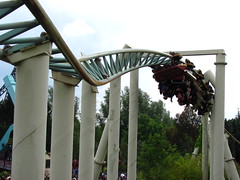
Colossus is like that. You level out of the turn and find yourself staring down a half mile long barrel of heartline rolls. They turn you over upside down and then rightside up at a constant unvarying rate, feeling like you’ve been put in the tumble dryer at the lowest setting. Because you’re following a perfectly straight heartline path at a constant speed you lose all sense of movement through space, the horizon remains fixed (save for the spinning), and there’s no gravitational forces except for that constant 1 G pushing you out and around your seat as orientations to earth change. You start feeling a little bit sick. When you emerge from the final barrel roll and are cruising along the last turn you ask yourself: What The Hell?
Colossus doesn’t completely ignore theatricality as at the end of this turn while everyone is still scratching their heads in confusion over the last set of inversions, the final 10th flip is tucked sneakily behind a row of shrubs and flips us through another roll before gliding into the brakes. Everyone is caught off guard and yanked out of their seats one last time, the promise of catharsis fulfilled by this surprise maneuver without feeling like it wimped and sold out to conventionality after a bold attempt to defy convention.
The majority of reviews I’ve read indicate a general disapproval of the quad heartline rolls on Colossus, and indeed I myself had an initial negative reaction to them, but then I realized that was what made this finale so brilliant. It wasn’t that the inversions themselves were so horrible (in terms of pure sensation they’re a fairly neutral element) but my aversion to them made me question why that was the case, why do I deem something good or bad, what is the mechanism that correlates the external world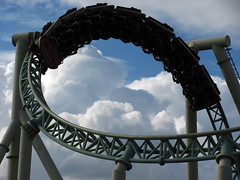 of representation with my internal world of aesthetic enjoyment. In other words, what does this ride mean for me? It doesn’t. But why?
of representation with my internal world of aesthetic enjoyment. In other words, what does this ride mean for me? It doesn’t. But why?
That’s less a statement about the ride than it is a statement about myself. In the end I found Colossus to be a better ride precisely because I didn’t completely like it. A perfect ride in its place would have been imperfect, I would have exited with a positive review and moving onto my next objective before I had even got down the stairs. Colossus, on the other hand, got me to doing some real roller coaster philosophy, which is all I could ever ask for.
Next door was a worse ride precisely because I completely hated it. (Whew, equilibrium has been restored!)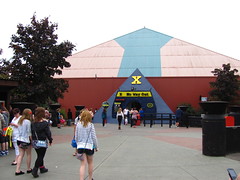 X:\ No Way Out, nearly as torturous to ride as it is to pronounce, was actually a coaster I was somewhat looking forward to, if only because I hoped to dismiss all the negative comments I’ve heard lobbed at it from fans online. The pyramid invited mystery, I would not be privy to what was around the next corner on my first time through, and it seemed like an opportunity for a unique, atmospheric ride. Complaints that it’s pointless or just a random series of starting and stopping didn’t seem like a fatal sin to me; perhaps I just needed to approach it more as a dark ride than a roller coaster?
X:\ No Way Out, nearly as torturous to ride as it is to pronounce, was actually a coaster I was somewhat looking forward to, if only because I hoped to dismiss all the negative comments I’ve heard lobbed at it from fans online. The pyramid invited mystery, I would not be privy to what was around the next corner on my first time through, and it seemed like an opportunity for a unique, atmospheric ride. Complaints that it’s pointless or just a random series of starting and stopping didn’t seem like a fatal sin to me; perhaps I just needed to approach it more as a dark ride than a roller coaster?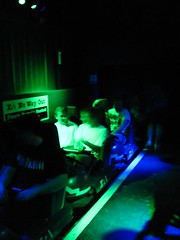
After a long stretch of corridors I arrived in the platform and the vehicles set off… backwards (uh, did I know about that?) After some lifts we got to a ride that was a more intense roller coaster than I was expecting, with some tight, swooping turns and drops that reminded me somewhat of a small, backwards Eurosat. Then we got to a block brake, and the train suddenly stopped. Then we were pushed forward a foot or two, then abruptly halted again. Then we were quickly pushed back off the block brake and into the next segment of the ride, where the process was repeated. Something about that stopping and starting and stopping motion coupled with the backwards seating really started to make me feel queasy in a way I’ve not experienced on a coaster in a very long time, if ever, and after a minute or two I was really wanting to just get it over with so I could go puke in the bushes or something. Instead it kept stopping and starting and stopping and starting and stopping…
While I don’t think I was ever in any real danger of losing my… (oh, that’s right, I hadn’t eaten yet today), I decided X%<WTF: No Way Out was still an unpleasant experience that didn’t require any repeats during my natural lifespan unless I turned particularly masochistic, and went over to let my stomach settle on some local classic spin and spews. First up was Rush, an S&S Screamin’ Swing, I believe the first of their 32 seat models. Good ride, not too long of a wait, and a few more swings at full height than you used to get on Cedar Point’s larger version. Just watch out for falling bits of metal. Next was the Vortex, a KMG Afterburner, also a fun ride. Maybe they can upgrade it to the new lapbar-only seats that debuted at IAAPA 2010 in the next year or two?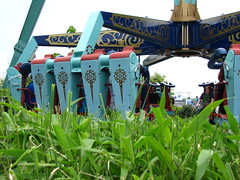 Last for me was the Zodiac, a HUSS Enterprise, always an enjoyable first-person experiment in centrifugal force. There was at least one more medium-sized Falling Star flat ride in the immediate vicinity, as well as a Mondial Top Scan and S&S Sky Swatter behind Colossus and Saw that I would do later in the day. Thorpe Park must have one of the best collections of modern flat rides I’ve seen at an amusement park, perhaps second only to Canada’s Wonderland.
Last for me was the Zodiac, a HUSS Enterprise, always an enjoyable first-person experiment in centrifugal force. There was at least one more medium-sized Falling Star flat ride in the immediate vicinity, as well as a Mondial Top Scan and S&S Sky Swatter behind Colossus and Saw that I would do later in the day. Thorpe Park must have one of the best collections of modern flat rides I’ve seen at an amusement park, perhaps second only to Canada’s Wonderland.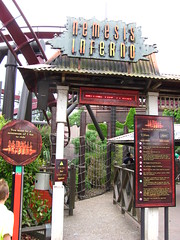
I moved on along the back of the park to Calypso Quay, where Nemesis Inferno was awaiting my impressions. It’s a good thing I went to Thorpe before Alton Towers, as the comparison to a vastly superior ride I can only imagine does it little service to guests that grew up at the Staffordshire park. Isn’t that always the case with sequels to beloved franchises? I, however, would board Nemesis Inferno a blank slate, or, at least a slate already coated with a universal skepticism towards all B&M rides that didn’t start Inferno on any worse footing than would have otherwise been the case. I was expecting Nemesis Inferno to be my least favored B&M invert I’d ever go on. Maybe it was. I can’t think of many B&M’s that I actively hate, but I can think of many that leave me feeling empty. I saw a small, short ride with four cookie-cutter loops strung together that ends with a sigh and had trains with only 87.5% the capacity of a standard invert to boot. I got something a bit better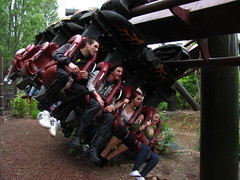 than all of that, but I’m still not sure if it was a particularly good ride or not.
than all of that, but I’m still not sure if it was a particularly good ride or not.
It starts with an extended prelift stretch of track I had nearly forgotten about. Curving drop out of the station, into a tunnel through the plaster volcano, wave the mist out of your glasses, listen to the local enthusiasts complain about the absence of themeing inside the tunnel, go over a small tilted bunny hop, flip the bird to the chav spraying you with silly string,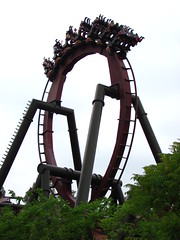 climb the lift hill. Hydra accomplishes a bit more with less track, but I’ll allow this as the one original idea in the entire coaster’s layout.
climb the lift hill. Hydra accomplishes a bit more with less track, but I’ll allow this as the one original idea in the entire coaster’s layout.
 The start of the ride is basically a copy of Batman: The Ride, which is pretty much a good thing, except the more modernized design techniques remove it of some of its edge. The loop is a bit more rounded producing more consistent positive G’s, and one thing I like was how the obligatory zero-g roll that follows ran out of building space and continues the twisting motion
The start of the ride is basically a copy of Batman: The Ride, which is pretty much a good thing, except the more modernized design techniques remove it of some of its edge. The loop is a bit more rounded producing more consistent positive G’s, and one thing I like was how the obligatory zero-g roll that follows ran out of building space and continues the twisting motion of the roll directly into the right
of the roll directly into the right hand turn that follows before leveling out. So far it’s a faster paced ride than I expected, and I do like rides with good pacing.
hand turn that follows before leveling out. So far it’s a faster paced ride than I expected, and I do like rides with good pacing.
Finishing with the turn B&M get creative by copying every other sitdown looping coaster they’ve ever made with a series of interlocking corkscrews followed by a figure-eight / helix finale (but it’s on an inverted coaster!) Save for Dueling Dragons there aren’t any other inverted coasters with these interlocking corkscrews, and given the fact that we can’t see what’s above us on an inverted coaster I suspect there to be a reason for that; it’s an element for the crowds watching below.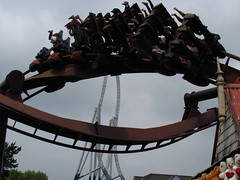 There is a fast snap in the transition between the corkscrews however, and my feet got very close to the murky puddles standing in as “quay themeing” underneath all the layout’s valleys, so that was also cool and beyond my expectations. The figure-eight finale is fast enough with some noteworthy positive G’s around the corners; in most other contexts it would be a forgettable finish, but here I’m still reveling in the fact that somehow despite appearances the core ride is lasting longer than thirty seconds (about 35 seconds according to the POV video). It’s still a bit forgettable. I disembark unoffended but unmoved, and also with hope I can catch glimpse of a kid with an aerosol can, but he’s long since absconded. His one smart idea.
There is a fast snap in the transition between the corkscrews however, and my feet got very close to the murky puddles standing in as “quay themeing” underneath all the layout’s valleys, so that was also cool and beyond my expectations. The figure-eight finale is fast enough with some noteworthy positive G’s around the corners; in most other contexts it would be a forgettable finish, but here I’m still reveling in the fact that somehow despite appearances the core ride is lasting longer than thirty seconds (about 35 seconds according to the POV video). It’s still a bit forgettable. I disembark unoffended but unmoved, and also with hope I can catch glimpse of a kid with an aerosol can, but he’s long since absconded. His one smart idea.
Detonator was the other large thrill ride in Calypso Quay, a 115 ft. tall Fabbri drop tower. I ran out of original things to say about drop towers a couple of reports ago and am now substituting a review with unrelated jokes. This one offers a moral about labor unions. A shop steward is at a convention in Paris and decides to visit a brothel. He asks the madam, “Is this a union house?”
“No, it’s not,” she replies.
“So how much do the girls earn?” the union man asks.
“You pay me €100, the house gets €80 and the girl gets €20.”
“That’s crass exploitation!” the man says and stomps out. Eventually he finds a brothel where the madam says it’s a union house. “If I pay you €100, how much does the girl get?” he asks.
“She gets €80.”
“That’s great!” he says. “I’d like Collette.”
“I’m sure you would,” says the madam, “but Thérèse here has seniority.”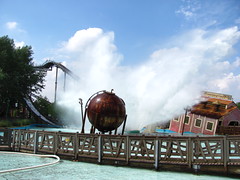
On that appetizing thought, I decided it time for a lunch which I found in the form of a Mexican cantina. (Thorpe has a lot of franchised fast-food locations that are both very overpriced and don’t accept the 20% discount for Merlin passes.) Nothing special to report here although it did remind me of an amusing phenomenon in Britain: most people have no idea how to properly pronounce Spanish / Mexican food names. I always got a few giggles when asked, “Would you like ja-lah-pa-nose on your kay-sa-dil-la?”
“Why, yes, I would love a few hah-la-pehn-yos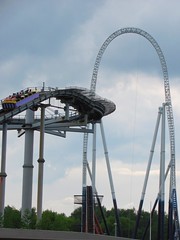 on my kay-sa-dee-yah, thank you.”
on my kay-sa-dee-yah, thank you.”
Hopefully these were just isolated incidents, but in case you’re British and have no idea what I’m talking about, a few tips the next time you’re ordering Mexican: J’s are pronounced like an H, double L’s become a Y, Ñ is a NY sound, and don’t even attempt the double R’s or you may get hurt.
Amity Cove is easily the best themed zone Thorpe has devised because the park can let it get dirty and then it only looks better (too bad they couldn’t have swapped it with Saw’s location and used an actual lakefront). While the original featured ride here was the massive, drenching, and still popular Tidal Wave, the new center of attention is on the 205 foot tall tower belonging to the 2006 Intamin accelerator coaster Stealth. Strangely this coaster had the shortest lines of the big four despite being the tallest and fastest, and as the only major ride with a single rider queue made it a very attractive camping location during the early afternoon when crowds were at their largest.
 On my first ride I’m in the front row. I pull the harness down over my head (too bad Intamin abandoned their lapbar-only design after only their first two accelerators, but the overhead style isn’t too restrictive on a ride with forces only along the vertical axis), and we prepare to launch. Unlike on other similar coasters there’s no separate launch preparation zone, we’re blasting out directly from the station house. While it denies the opportunity to wring some more suspense out of our scenario, it makes the tension during boarding much more real as we’ve just witnessed
On my first ride I’m in the front row. I pull the harness down over my head (too bad Intamin abandoned their lapbar-only design after only their first two accelerators, but the overhead style isn’t too restrictive on a ride with forces only along the vertical axis), and we prepare to launch. Unlike on other similar coasters there’s no separate launch preparation zone, we’re blasting out directly from the station house. While it denies the opportunity to wring some more suspense out of our scenario, it makes the tension during boarding much more real as we’ve just witnessed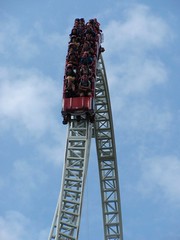 moments ago the previous train launch inches away from us, and as soon as the air gates open there’s no ‘safety net’ to defer the inevitable.
moments ago the previous train launch inches away from us, and as soon as the air gates open there’s no ‘safety net’ to defer the inevitable.
The launch has a very powerful takeoff, supposedly dialed up from 0-80 in 2.3 seconds to 1.8 seconds after its opening year; the extra time must have been shaved off near the start of the acceleration if the length of the launch track remained the same. The way up is the same as on the others, and the most effective moment for me remains the start of the crest going up the hill, when you’re totally disoriented and start to feel yourself being released from your seat for the first time at an unknown height and angle. As we crest over the top giving us a good look at the park and the distant countryside, I see something flying in the air. It’s a bird! It’s a plane! It’s… my cellphone.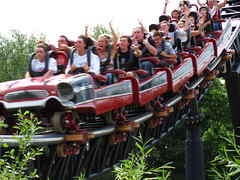
Uh-oh.
I guess with the combined backward force of the launch with the uphill climb of the tophat was enough to dislodge it from my horizontal pocket in the sitting position, and all that was needed then was a slight upward kick to set it in flight. And what a glorious flight path it took, fluttering through the open air like a silver butterfly, sailing away on its own free will from my outstretched palm, the metallic glint catching the sun as it soared over a field, across some rapid ride channels, where it made its final resting place in Davy Jones’ locker.
 We ourselves joined my communications device in its downward trajectory, only we were afforded the luxury of a gracious parabolic pullout to soften the landing to no more than three or four gravitational forces, then once again set in upward motion over the subsequent speed hill. Compared to the tophat this is really a negligible add-on, barely registering except for an odd combination of airtime with sudden deceleration at the crest. Actually for me the scariest part of the ride was on the brake run in the front row, as we seemed to have dangerously little space for deceleration before the track sharply curved back to the station, but somehow we slowed down enough for the last 50 feet that the remaining speed could be put away without much extra distance needed.
We ourselves joined my communications device in its downward trajectory, only we were afforded the luxury of a gracious parabolic pullout to soften the landing to no more than three or four gravitational forces, then once again set in upward motion over the subsequent speed hill. Compared to the tophat this is really a negligible add-on, barely registering except for an odd combination of airtime with sudden deceleration at the crest. Actually for me the scariest part of the ride was on the brake run in the front row, as we seemed to have dangerously little space for deceleration before the track sharply curved back to the station, but somehow we slowed down enough for the last 50 feet that the remaining speed could be put away without much extra distance needed.
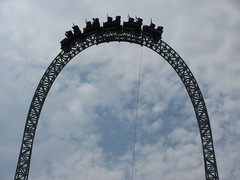 While I was slapping myself on the forehead for the first fifteen minutes after the ride was over (how embarrassing is it for an enthusiast to fall victim to the warnings intended for ‘regular park goers’, especially in the front row where everyone else behind you can see and are commenting on the floating device on the unload platform) I ultimately didn’t fret over it too much because it was a cheapo disposable model given free with the original contract from my travels in Italy, the chip I had replaced after arriving in the UK was about out of minutes anyway, and if I was going to have to get rid of it in the next couple of weeks, I could hardly think of a more entertaining way to see it off. My biggest problem was less that I lost audio contact with my parents and anyone else not within shouting distance, but that it was also the only device I had capable of telling me the time or waking me up in the morning. But those would be dilemmas for another day.
While I was slapping myself on the forehead for the first fifteen minutes after the ride was over (how embarrassing is it for an enthusiast to fall victim to the warnings intended for ‘regular park goers’, especially in the front row where everyone else behind you can see and are commenting on the floating device on the unload platform) I ultimately didn’t fret over it too much because it was a cheapo disposable model given free with the original contract from my travels in Italy, the chip I had replaced after arriving in the UK was about out of minutes anyway, and if I was going to have to get rid of it in the next couple of weeks, I could hardly think of a more entertaining way to see it off. My biggest problem was less that I lost audio contact with my parents and anyone else not within shouting distance, but that it was also the only device I had capable of telling me the time or waking me up in the morning. But those would be dilemmas for another day.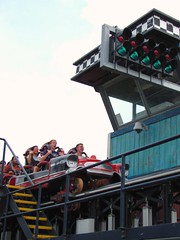 In the meanwhile, I had Stealth re-rides to get, now able to enjoy with one less piece of junk to rattle around in my pockets.
In the meanwhile, I had Stealth re-rides to get, now able to enjoy with one less piece of junk to rattle around in my pockets.
Although I could argue the oft-employed criticism that Stealth is a rather pointless ride if you’re well acquainted with bigger and better variants of the same idea (which I am), I found one fatal flaw with this line of reasoning: we do not experience the world from a universalist, non-positional perspective. When you’re actually sitting there, racing down the track at 80mph to climb a 200ft. tall twisting tower, it doesn’t matter that there’s a 128mph, 456ft. tall version across the Atlantic, what you’re experiencing in that moment right now should still be pretty cool in its own right. That I can barely recall Stealth to memory when I think of my favorite European attractions should tell you one thing, but the fact that I rode it some six or seven times in a row before moving on should tell you another. It’s one of those rides I’d never wait a half hour for, but if the queue is less than five minutes you couldn’t pry me away without the promise of something better around the next corner.
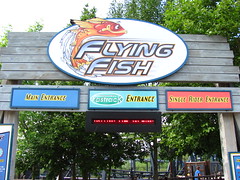 In that corner, way the heck away from the rest of the dry park’s infrastructure tucked behind the wannabe water park, is the Flying Fish, another Mack Blauer Enzian, which I stopped by for the quick credit grab. It shares a unique common
In that corner, way the heck away from the rest of the dry park’s infrastructure tucked behind the wannabe water park, is the Flying Fish, another Mack Blauer Enzian, which I stopped by for the quick credit grab. It shares a unique common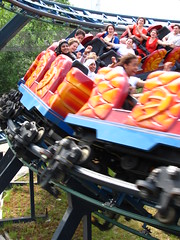 linkage with Stealth as being the only other ride in the park with a single rider queue, and a Fast Track entrance. God help those who visit on a day in which these are necessary. I don’t know why this was resurrected after being evicted by Stealth when it had to be relocated such a long distance from everything else and didn’t even have a decent setting like Chessington’s Runaway Train, though I guess something should be said for Thorpe’s loyalty to their past.
linkage with Stealth as being the only other ride in the park with a single rider queue, and a Fast Track entrance. God help those who visit on a day in which these are necessary. I don’t know why this was resurrected after being evicted by Stealth when it had to be relocated such a long distance from everything else and didn’t even have a decent setting like Chessington’s Runaway Train, though I guess something should be said for Thorpe’s loyalty to their past.
Crossing the park along the back rim to the east, I found two more notable flat thrill rides, one being the Slammer, an S&S Sky Swat, and the first of its kind I’d ever been on. It’s an interesting concept and certainly unlike any other flat ride I’ve ever been on. The idea is that by positioning the seats on top of each end of a rotating arm like paddles, they’ll be able to achieve continuous weightlessness when the entire apparatus is rotated vertically. This principal does seem to be in effect, though I found it didn’t become the defining dynamic of the ride, where just as strong a force was applied to pushing us into the back of our seats, and overall it was a better ride for the vertigo of going over the top and upside down than it was for the accompanying forces.
to achieve continuous weightlessness when the entire apparatus is rotated vertically. This principal does seem to be in effect, though I found it didn’t become the defining dynamic of the ride, where just as strong a force was applied to pushing us into the back of our seats, and overall it was a better ride for the vertigo of going over the top and upside down than it was for the accompanying forces.
Samurai, the Mondial Top Scan relocated from Chessington a few years back, seems to have found success in Thorpe Park where it was consistently the longest queued for flat ride in the park. It certainly appears to be the most discombobulating, extremely rapid spinning combined with seats attached to rotating arms looks like a challenge from off-ride. On ride was just a lot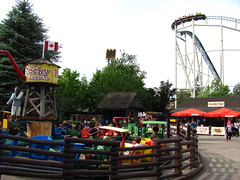 of lateral forces of undulating strength mixed with a nauseating back and forth rocking of the seats, rarely working up the courage to do anything more interesting like a full front flip. I wonder how long it will take before Ramses Revenge makes the move from Chessington to Staines.
of lateral forces of undulating strength mixed with a nauseating back and forth rocking of the seats, rarely working up the courage to do anything more interesting like a full front flip. I wonder how long it will take before Ramses Revenge makes the move from Chessington to Staines.
In the furthest corner of the park was Canada Country, a pleasant retreat filled with trees and devoid of any towering mechanical thrill rides. The principal attraction was the Logger’s Leap,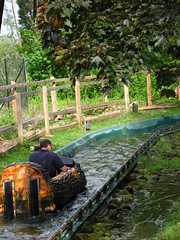 a kindred spirit to Chessington’s Dragon Falls, and one of the more pleasant surprises Thorpe Park has to offer. Assuming you don’t swallow any bugs, the log flume’s setting is a very naturalistic one taking place mostly at ground level, cutting across marshland and through a densely wooded peninsula nearby the lake. Some surprises such as a splashdown in a tunnel make their appearances throughout the length of the flume’s course, and the biggest drop saved for last, a double dip that Wikipedia tells me is the largest such drop on a traditional flume ride in the UK. Refreshing the “it’s like a mini-Cedar Point” comparisons, I found this entire nook of the park very reminiscent of Frontier Trail / Town prior to 2006, when you could generally count on to not be as crowded as the rest of the park and the signature attraction was a classic log flume set amid a dense canopy, a seemingly improbable discovery given the rest of the park is little more than concrete riverbeds set in steel canyons.
a kindred spirit to Chessington’s Dragon Falls, and one of the more pleasant surprises Thorpe Park has to offer. Assuming you don’t swallow any bugs, the log flume’s setting is a very naturalistic one taking place mostly at ground level, cutting across marshland and through a densely wooded peninsula nearby the lake. Some surprises such as a splashdown in a tunnel make their appearances throughout the length of the flume’s course, and the biggest drop saved for last, a double dip that Wikipedia tells me is the largest such drop on a traditional flume ride in the UK. Refreshing the “it’s like a mini-Cedar Point” comparisons, I found this entire nook of the park very reminiscent of Frontier Trail / Town prior to 2006, when you could generally count on to not be as crowded as the rest of the park and the signature attraction was a classic log flume set amid a dense canopy, a seemingly improbable discovery given the rest of the park is little more than concrete riverbeds set in steel canyons.
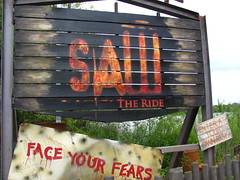 From the nostalgic past we fast-forward to the present day of postmodern discontentment and ennui with the final major attraction Thorpe Park had on offer, Saw: The Ride. While my initial reaction to the choice of intellectual property was only slightly less perplexed than the Led Zeppelin and Moody Blues rides that opened the prior season, upon further reflection it seemed to make a lot of sense. Here finally was a roller coaster that told us loud and clear “I’m for older teens and adults only,” which isn’t really true but the adult coaster nerds out there don’t like it as much when their 300 foot tall extreme machines are painted Cartoon Network colors and given a first-grade reading level moniker. (Hey, I need these things to make me appear tough and manly to get all the chicks! Doesn’t work when I’m sitting next to an 11 year old kid.)
From the nostalgic past we fast-forward to the present day of postmodern discontentment and ennui with the final major attraction Thorpe Park had on offer, Saw: The Ride. While my initial reaction to the choice of intellectual property was only slightly less perplexed than the Led Zeppelin and Moody Blues rides that opened the prior season, upon further reflection it seemed to make a lot of sense. Here finally was a roller coaster that told us loud and clear “I’m for older teens and adults only,” which isn’t really true but the adult coaster nerds out there don’t like it as much when their 300 foot tall extreme machines are painted Cartoon Network colors and given a first-grade reading level moniker. (Hey, I need these things to make me appear tough and manly to get all the chicks! Doesn’t work when I’m sitting next to an 11 year old kid.)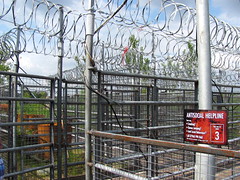
Too bad it couldn’t have been a coaster themed to a good horror film like Let the Right One In, I only ever saw the first Saw and had no desire to see any further installments. Okay, good first ten minutes when they wake up in the room neither they nor the audience know what’s going on, plus an okay final scene. Everything else in between was the most boring compost of unnecessary side plots, flashbacks, and tedious, self-serious monologues. Keep the entire thing two guys locked in the room with puzzles to solve before they lose another appendage, and don’t leave that story line for a second. Make us feel as alone and scared as they are, then it might actually be a little suspenseful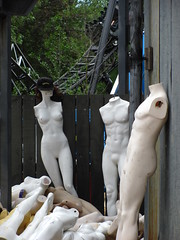 and scary. Incidentally, the only part of the film I’d call inspired was when the dude goes reaching through the pile of excrement in the toilet bowl only to find the clue he was searching for stowed cleanly away beneath the tank lid. We don’t need psychopathic killers to make our skin crawl; we can do it to ourselves with our own stupidity.
and scary. Incidentally, the only part of the film I’d call inspired was when the dude goes reaching through the pile of excrement in the toilet bowl only to find the clue he was searching for stowed cleanly away beneath the tank lid. We don’t need psychopathic killers to make our skin crawl; we can do it to ourselves with our own stupidity.
Until I rode the coaster I had forgotten that Jigsaw is a bit of an existentialist thinker. You don’t understand what it means to live until you confront your own mortality, yada yada ya. If Jigsaw were ever to try to pull his crap on me, first thing I’d tell him is to go back and reread his copy of Heidegger. One does not achieve being-toward-death (Sein-zum-Tode) merely through the immediate apprehension of a clinical death, but it is rather an on-going state of awareness of death that brings one closer to an authentic there-being (Dasein). Because this awareness is not an empirical process that can be brought about by observing a specific numeric object or event, forcing knives or witnessing others die would be of little use to Jigsaw’s stated project.
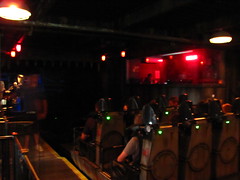 We’ll let those thoughts linger as Jigsaw finishes up his spiel. Be sure to get the second car in the loading platform at least on your first time, the lead car just breezes past the preshow into the coaster section for blocking purposes. Moving forward, the interior set design isn’t quite as good as that seen on Mystery Mine (plus no undulating trick-track), but we are greeted with a pretty wild kick-off just a few seconds in with a sharp vertical plunge nearly missing some blades before twisting back up and into a block segment. A bunch of guns pointed as us fire harpoon-like noises, but we’ll have to use our imaginations to fill in the lethal flying object of our choice. We advance forward in the dark through another twisting drop that feeds immediately into a slow, straight heartlined barrel roll (because Gerstlauer figured
We’ll let those thoughts linger as Jigsaw finishes up his spiel. Be sure to get the second car in the loading platform at least on your first time, the lead car just breezes past the preshow into the coaster section for blocking purposes. Moving forward, the interior set design isn’t quite as good as that seen on Mystery Mine (plus no undulating trick-track), but we are greeted with a pretty wild kick-off just a few seconds in with a sharp vertical plunge nearly missing some blades before twisting back up and into a block segment. A bunch of guns pointed as us fire harpoon-like noises, but we’ll have to use our imaginations to fill in the lethal flying object of our choice. We advance forward in the dark through another twisting drop that feeds immediately into a slow, straight heartlined barrel roll (because Gerstlauer figured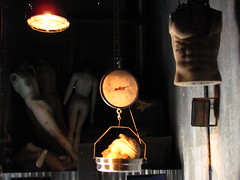 you didn’t get enough of them on Colossus, apparently). However it’s a cool element to end the indoor section with because not only does it leave you hanging, it leaves you hanging over a dead body that ruptures with a blast of water that gets very close to washing our scalps. I admit I closed my eyes and ducked not just on the first time through, but for at least the next four or five rides after. Great effect.
you didn’t get enough of them on Colossus, apparently). However it’s a cool element to end the indoor section with because not only does it leave you hanging, it leaves you hanging over a dead body that ruptures with a blast of water that gets very close to washing our scalps. I admit I closed my eyes and ducked not just on the first time through, but for at least the next four or five rides after. Great effect.
We roll out of the building into a brake run, where we then navigate a flat 180° turnaround to approach the base of the lift. We hear another brief warning from Jigsaw over the speaker (but, duh, haven’t we just escaped?) and then tilt all the way on our backs squinting into the sunlight. Despite the 100’ height we’re taking the most direct route possible to reach the apex and so waste little time before we’re quickly cresting over and then staring back down at the brown ground. Despite being the steepest free-falling drop on a roller coaster in the world at 100°, there’s not as powerful air on the first drop as I might have expected, because most of the curvature over the top (which generates the negative g’s out of the seat) is completed within ten feet of the top, the rest is just a straight freefall only capable of generating weightlessness, not negative g’s. Not to belittle what is still the best drop in the region.
Not to belittle what is still the best drop in the region.
The shredders at the bottom of the drop are hardly noticed due to the great speed, plus being on a positive-G inward curvature makes headchoppers less effective than if placed over a negative-G outward curvature. We flip up into the first element, a large, circular dive loop where the banking rotation on the exit sweeps back and forth up into the next element, a high overbank that could be close to qualifying as its own inversion. Sadly it’s also around here that I note an odd shuffling from what seems to be the car’s axels, as if the wheels aren’t gripping the track properly and allowing the chassis to shutter back and forth every couple of inches, the effect almost
and forth every couple of inches, the effect almost like the rails are formed from tiny segments of straight pipe such as in a videogame rendering. It’s a bit rough but I don’t see any reason to let that spoil the fun like some people claim.
like the rails are formed from tiny segments of straight pipe such as in a videogame rendering. It’s a bit rough but I don’t see any reason to let that spoil the fun like some people claim.
More worrying for me in fact is the shoulder harness, which seems to be yet another design that will too-easily ratchet tighter on high G-force turns, so I become self conscious of my need to constantly hold it up off my body so it doesn’t ruin the big airtime camelback hill which is next. Everyone throw your hands in the air for a second or two of powerful ejector on the best camelback hill in all of England! (Wales doesn’t count, otherwise that’d be a different story.) There’s a snaky swivel
different story.) There’s a snaky swivel to the right on the exit that anticipates the left turn up to the next block brake, and a reprieve is granted before the last trick in Saw’s canon.
to the right on the exit that anticipates the left turn up to the next block brake, and a reprieve is granted before the last trick in Saw’s canon.
The breath we regained is again quickly stolen by a very sharp, punishing straight drop with zero lead time into the ejector negative forces. The last maneuver is my favorite on the ride, a petite Immelmann that manages with an unlikely nimbleness to twist us completely upside-down in a split second before naturally continuing the curve around the back half of the vertical loop. Pulling up out of a small concrete trench the car tips around one last quick banked turn before leveling out in an elevated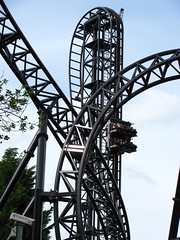 brake run that deposits us back in the station. As we exit, Jigsaw offers us some final parting words of wisdom on what we should do with our new outlook on life after our brush with death, which I think is to buy some junk at the gift shop downstairs.
brake run that deposits us back in the station. As we exit, Jigsaw offers us some final parting words of wisdom on what we should do with our new outlook on life after our brush with death, which I think is to buy some junk at the gift shop downstairs.
Aside from fixing the unnecessary shunting of the vehicles on the high-speed sections (which I think might be worse on the outside rows than inside, though as a single rider I was almost always on the outside left so I didn’t get to experiment much with that) the biggest change I would have made to Saw would be to enclose the whole track up to the base of the lift indoors with more theatrical dark ride scenes. Our first glimpse of the outdoors really should be after we’re on our backs and have begun the second half of the ride when it no longer matters that we’ve been removed from a setting conducive to our claustrophobia or nyctophobia. With the long transition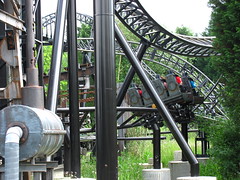 sitting outside in the open air it sort of kills the continuity between the first and second acts of the coaster’s narrative structure. Added together the sum is still a better ride… but neither indoor nor outdoor segment improves or sets context by the other’s presence, and the result is a mildly schizophrenic affair that doesn’t quite congeal into the singular, complete experience it ought to be. Mystery Mine did a better job at this by sequencing itself indoor-outdoor-indoor-outdoor that emphasized repetition and circular continuity rather than a simple indoor-outdoor structure which turns the story into a purely linear progression that’s forgetful of history. However Mystery Mine also suffers from this same problem: too much of the ride prior
sitting outside in the open air it sort of kills the continuity between the first and second acts of the coaster’s narrative structure. Added together the sum is still a better ride… but neither indoor nor outdoor segment improves or sets context by the other’s presence, and the result is a mildly schizophrenic affair that doesn’t quite congeal into the singular, complete experience it ought to be. Mystery Mine did a better job at this by sequencing itself indoor-outdoor-indoor-outdoor that emphasized repetition and circular continuity rather than a simple indoor-outdoor structure which turns the story into a purely linear progression that’s forgetful of history. However Mystery Mine also suffers from this same problem: too much of the ride prior to the big lift is set outdoors. I guess building indoor themed sets is just a really expensive undertaking.
to the big lift is set outdoors. I guess building indoor themed sets is just a really expensive undertaking.
Saw: The Ride remains by a margin my favorite single attraction at Thorpe Park, mostly because the long ride time with multi-part progression makes it the most full-bodied experience,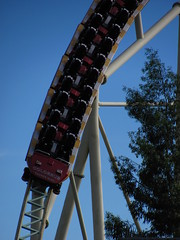 especially when it’s located in a nation where most coasters last barely 45 seconds from the start of the action to the brake run. Colossus was narrowly my second favorite, probably because it and Saw were the only two rides that were wholly unique to me. Stealth was fun when I wasn’t watching my cellphone sail away, as was Nemesis Inferno when I wasn’t getting hit in the face with silly string, and Logger’s Leap remains the best non-coaster ride in the park. For flat/tower rides I’d be most likely to go on the contributions by S&S Power again, although such rides tend to reflect personal tastes rather than subject to a categorical criterion. I look forward to their 2012 and 2015 coasters which should mark the final transformation into a proper ‘Thrill Park’ with its own unique identity in its collection of rides rather than the pocket-sized Cedar Point it currently still reminds me of.
especially when it’s located in a nation where most coasters last barely 45 seconds from the start of the action to the brake run. Colossus was narrowly my second favorite, probably because it and Saw were the only two rides that were wholly unique to me. Stealth was fun when I wasn’t watching my cellphone sail away, as was Nemesis Inferno when I wasn’t getting hit in the face with silly string, and Logger’s Leap remains the best non-coaster ride in the park. For flat/tower rides I’d be most likely to go on the contributions by S&S Power again, although such rides tend to reflect personal tastes rather than subject to a categorical criterion. I look forward to their 2012 and 2015 coasters which should mark the final transformation into a proper ‘Thrill Park’ with its own unique identity in its collection of rides rather than the pocket-sized Cedar Point it currently still reminds me of.
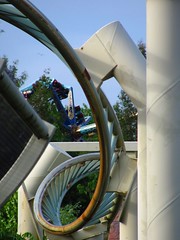
Comments